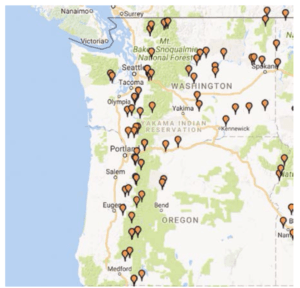Climate change may pose a serious risk to the nation’s electric grid, according to a new report.
The report was prepared by Johns Hopkins University with help from Swiss Re.
“Lights out: The risks of climate and natural disaster related disruption to the electric grid” is the fourth report on which the university and international reinsurer have partnered.
Last year the collaborative produced a report on the impact of climate change on the spread of pandemics, which was covered by Insurance Journal. Previous reports produced by Johns Hopkins and Swiss Re were on climate and wildfire risk in the U.S., and on resiliency in the Columbia River basin.
The latest report calls attention to the risk of climate change creating more frequent extreme weather events.
The report states that climate change “presents epistemic risks beyond predictable, ordinary weather-related risks to the electric grid,” which could put the structural integrity of the nation’s ageing electric infrastructure under greater strain.
“A combination of higher average temperatures, more destructive storms and hurricanes, and increased risk of wildfire will ultimately worsen risk exposure for utilities,” the report states.

The insurance industry takeaway from the report should be that there’s a massive protection gap in the nation’s electric grid, said Alex Kaplan, head of global partnerships in North America for Swiss Re.
Kaplan, who served as the senior advisor for the report, wasn’t referring to electric plants and the homes and businesses to which they supply power, but the oodles of transmission units, power poles and power lines that keep our country abuzz.
“It is entirely uninsured,” Kaplan said. “You have literally all these power lines, all these poles that support these powerlines, are totally uninsured.”
An example of what extreme weather can do to a power system that’s outlined in the report is Hurricane Iniki in 1992, which destroyed much of Kauai’s distribution and transmission infrastructure, knocking down 5,000 utility poles and wiping out a large chunk of the island’s distribution wire system.
Electricity was disrupted on the entire island for weeks to months in some areas. Full restoration of power took three months.
“They didn’t have any way to get that transmission moving again,” Kaplan said.
The report also draws upon exposure in the Pacific Northwest, which supplies the nation a large portion of its hydroelectric power, as an example that should raise concerns about the impact of climate change on the electric grid.
“In Washington State, where hydropower accounts for nearly 70 percent of total electricity generation, diversification of energy sources is of growing importance,” the report states.
Washington is the leading source hydroelectric power production in the U.S., followed by Oregon, according to the U.S. Department of Energy.
“Oregon and Washington are both surplus power producers, generating more electricity than they consume and supplying Canadian and U.S. markets with significant electricity,” the report states.
According to the report, fluctuations in precipitation and runoff, both indirectly associated with temperature, have a more direct impact on expected hydropower generation.
“In most cases, higher average temperatures as a result of climate change may increase the amount of precipitation that falls as rain instead of snow, leading to earlier snowmelt in the spring and overall reduced snowpack,” the report states.
While air temperature is projected to increase annually and seasonally for the near term to 2030 in the Pacific Northwest, the increase in temperature may not have a strong direct influence on annual water runoff, but it will cause significant changes in seasonality – an earlier snowmelt in spring combined with decreased summer precipitation.
“While higher temperatures are projected to lead to increased winter rainfall that could be used to generate more power, this additional precipitation increases the probability of dam spilling, mostly in April and May,” the report states. “This poses challenges to hydropower operation and maintenance, in terms of managing the various other uses of dams, ranging from flood control, navigation, fishery and ecosystem restoration. For example, hydropower plant managers might find there is insufficient water for both power generation and fish conservation, even when there seems to be large volumes of water flowing in the spillway.”
Additionally, higher average temperatures can reduce the efficiency and capacity of electric lines and other grid components, such as transformers. A a rise in temperature, for example, can cause conductors to physically expand, making it more likely for power lines to shut off and result in automatic power outages, according to the report.
“The transmission capacity of the grid is put under even greater strain during the summer, when temperatures rise and electricity demand peaks,” the report states. “In Seattle, for example, higher average summer temperatures have forced the Seattle City Light utility to install more cooling fans in control stations to prevent equipment malfunction.”
This is all evidence, in Kaplan’s view, that the insurance industry has an opportunity to step in and provide products to help deal with this risk instead of relying on utilities foot the bill – and ultimately pass the buck on to rate payers – or for the government to step in with emergency funding.
“There is the capability of transferring that risk off of private citizens into private market,” he said.
He is referring to mechanisms like parametric products and index-based solutions, which he said have been developing at a rate that’s “absolutely encouraging.”
“If we can avoid sending these costs though to populations, and particularly low-income populations, that’s pretty important,” he said.
Data from the North American Electric Reliability Corporation shows that of 2,428 total unplanned electric grid outages in the Western U.S. in 2015, nearly one-fourth were caused by extreme weather events and variability in environment.
“Moreover, the U.S. insurance industry has identified a $20 to $55 billion annual financial loss from power outages caused by flooding, hurricanes and extreme temperatures,” the report states.
Past columns:
- 5.4M U.S. Homes at Risk from Sea Level Rise, Report Using Census Data Shows
- 12 States Call Out California’s ‘Affront to Sound Insurance Regulation’
- Climate Change Advocates Galvanized by Trump Decision
- Report: Climate Change to Increase Insured Losses from Windstorms in the U.K.
- Global Temps Could Hit 1.5°C Target in 9 Years: Research
Topics USA Washington Market Climate Change
Was this article valuable?
Here are more articles you may enjoy.



 Class Action Accuses Toyota of Illegally Sharing Drivers’ Data With Progressive
Class Action Accuses Toyota of Illegally Sharing Drivers’ Data With Progressive  Progressive Insurance Is Hiring Again; 12,000 More People Needed
Progressive Insurance Is Hiring Again; 12,000 More People Needed  Heritage Files Libel, Defamation Suit vs. Adjuster After ’60 Minutes’ Report
Heritage Files Libel, Defamation Suit vs. Adjuster After ’60 Minutes’ Report  The Good and Bad About Being an Independent Insurance Agent
The Good and Bad About Being an Independent Insurance Agent 

